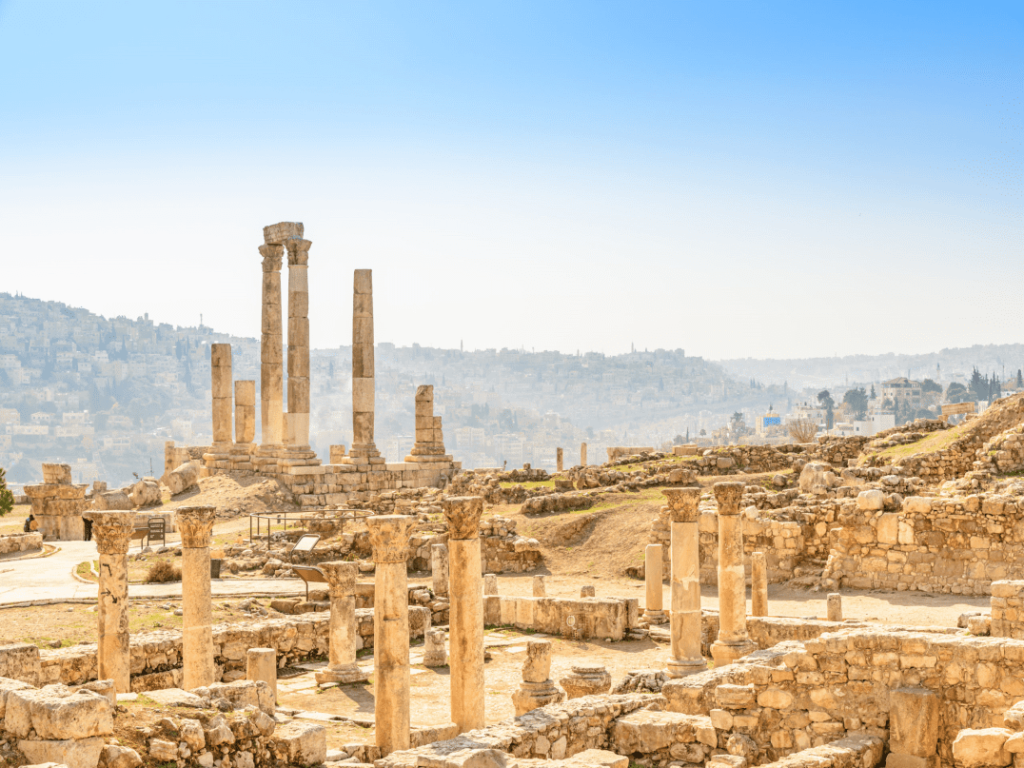The Amman Citadel (also known as Citadel Amman) sits proudly on top of Jabal Al-Qal’a, a historic hill in the heart of Jordan’s capital. This remarkable archaeological site is not just a Roman citadel; it is a living timeline where Ammonite, Hellenistic, Roman, Byzantine, and Umayyad civilizations all left their mark.
Considered one of the oldest continuously inhabited places in the world, the Amman Citadel is a must-visit for anyone curious about history, culture, and the story of Jordan.
Highlights of Amman Citadel
The Citadel Amman is full of landmarks that reveal its rich and layered history.
The Temple of Hercules – The Icon of Citadel Amman
- Built during the Roman period, this grand temple is the most famous landmark inside the Amman Citadel.
- Although only massive columns remain today, archaeologists discovered a giant hand believed to be part of a colossal statue of Hercules.
- Some researchers suggest the statue could have been larger than any in Rome, making this Roman citadel even more impressive.
The Umayyad Palace and Byzantine Church
- Next to the Roman ruins stands the Umayyad Palace, a beautiful example of early Islamic architecture.
- Visitors can also explore the remains of a Byzantine church, reflecting the multi-layered history of this citadel.
The Jordan Archaeological Museum
- Established in 1951, the museum is located inside the Amman Citadel.
- It houses priceless artifacts, including the Amman Citadel Inscription, the oldest known example of the Ammonite language.
Why Is Amman Citadel One of the Most Impressive Roman Ruins?
Several unique features make the Amman Citadel stand out among Roman ruins:
- Deep history: From Neolithic settlements to the Bronze Age, from Roman dominance to Islamic rule, this citadel tells a story that spans thousands of years.
- Breathtaking views: Perched high above downtown Amman, the citadel offers panoramic views of the city, connecting the modern capital with its ancient roots.
- Cultural richness: A blend of Roman temples, Byzantine churches, and Umayyad palaces makes Citadel Amman a true cultural mosaic.
How to Visit the Citadel?
Getting to the Amman Citadel is easy:
- Take a taxi or drive — it’s only 5–10 minutes from downtown Amman
- You can also walk from the old city (if the weather is nice!)
- Entry is affordable, and often free for Jordanian citizens
Tips for Your Visit:
- Bring your camera — the view is amazing!
- Visit early morning or before sunset for the best light
- Bring water, especially in summer
- Read a little about the site before you go — it’ll make your visit more meaningful
Useful Words to Learn (for Arabic learners):
| Word | Meaning |
|---|---|
| Qal‘a (قلعة) | Citadel |
| Athar (آثار) | Ruins / Antiquities |
| Romaniyyīn (رومانيين) | Romans |
| Ma‘bad (معبد) | Temple |
| Mathaf (متحف) | Museum |
Conclusion
The Amman Citadel is more than just a pile of old stones. It’s a living window into Jordan’s rich history. Whether you call it the Roman Citadel or the Citadel Amman, it stands as a powerful reminder of ancient civilizations — right in the heart of modern Amman.
If you’re learning Arabic, a visit to the Amman Citadel is the perfect chance to connect language with culture, history, and place.
If you wish to learn more about the Arabic language, download our Arabic learning app.



